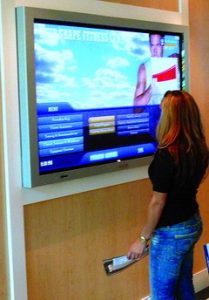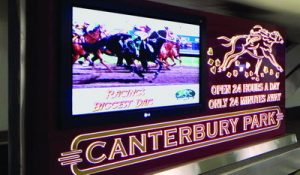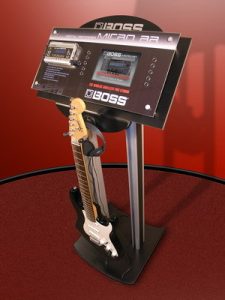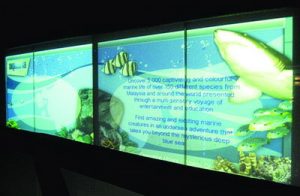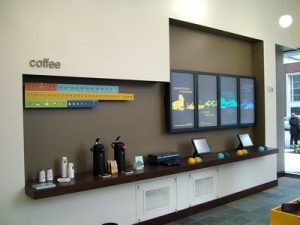The retail landscape is still filled with digital screens slapped on walls, playing repetitive content that shoppers ignore (and anyone working in the vicinity abhors).
But better, more highly evolved digital screen systems do exist. And six of the best have been singled out for honors in the third annual Digital Signage and Interactive Technology Awards. That competition was held in conjunction with the annual Digital Signage Expo (in Chicago in May) and judged by the editors of VM+SD.
This year’s winners are housed in a variety of venues, some commonplace (stores and banks) and some unexpected (like an airport baggage carousel). But no matter where they’re installed, all take a disciplined yet creative approach to providing digitally delivered images and information that engage and inform viewers.
Design Integration
The entries were segmented in six categories. The winner in the Environmental Design Integration category was Canterbury Park Racetrack and Card Club (Shakopee, Minn.) for its digital screens playing to a captive audience: airline passengers at a baggage carousel waiting for their luggage to arrive. The racetrack, located about 25 miles from the Minneapolis/St. Paul International Airport, previously had static signs at the airport to lure arrivals to the park.
To increase the effectiveness of that effort, the track had Wireless Ronin Technologies (Eden Prairie, Minn.) place two 42-inch LCDs in the airport’s main baggage-claim area that offer updateable information on races, card tournaments and other special events going on at the park. The airport screens are integrated with eight similar screens at the park itself, and all the screens at both locales are networked wirelessly, using cellular technology. That eliminates the need for any cabling connected to the screens’ media players – a real plus in an airport environment, where security considerations loom large.
Interactivity Innovation
Winner in the Interactivity Innovation category was Boss US, maker of the Boss guitar and other electronic musical instruments and audio equipment, which wanted to pump up the volume on sales of its Micro BR, a portable music recording studio that’s roughly the size of a paperback book. “The Micro BR can do some pretty amazing things – you can plug a guitar into it and overlay rhythm and accompaniment tracks, you can change the tone of the music, and even the sound of your guitar,” says Phil Gates, a product and marketing specialist with Los Angeles-based Boss US. “But it’s also fairly technical; it needs some explanation and training before it can be used.”
To provide that instruction, Boss teamed with Admart Custom Signage (Danville, Ky.) to create an in-store demonstration stand that consists of an Admart Interactive AdView DM8i screen connected to a Micro BR, an electric guitar and a set of headphones. “This is true interactivity – by pressing buttons on the display or touchscreen, users get lessons from an on-screen narrator on every aspect of using the BR,” says Gates.
Creative Content
Winner for the Best in Class Creative Content: Retail Store was the Zia Sleep Sanctuary Store in Eden Prairie, Minn., the brainchild of Minneapolis entrepreneur James Gabbert. He hired a design team consisting of three area firms to create a store for his idea of selling an in-depth assortment of sleep aids under one roof: KKE Architects, the Risdall Marketing Group and Wireless Ronin Technologies.
Digital signage plays an integral role in creating a relaxing and informative environment. The store entrance, for instance, features a blue portal with piped-in, soothing sounds that leads directly to a 7-by-5-foot screen providing information on the store’s mission and sleep-aid product offerings. In addition, touchscreens and interactive kiosks have been strategically placed throughout the space. “The digital technology has been instrumental as a branding tool, as well as a way to facilitate sales through customer education,” says Gabbert.
Best in Class Creative Content: Public Spaces went to the Aquaria in Ismail, Malaysia, which has more than 5000 species of sea life on display. To help guests navigate the aquarium’s numerous exhibits, Scala (Exton, Pa.), Click Grafix and Be Digital (both of Kuala Lumpur, Malaysia) were enlisted to install a digital signage network within it. At the main entrance, that team placed a 14-by-4-foot digital sign that provides general information on the aquarium and its exhibits via a mixture of graphics, text and video. Other elements of the system include three 61-inch plasma screens installed along a perimeter wall that faces a food court, and a 12-by-12-foot projection screen within its theater gallery.
Best in Class Creative Content: Hospitality went to Royal Caribbean Cruise Lines for the interactive digital signage at the spa and fitness centers aboard its 3600-passenger Freedom Class luxury liners. The system, by Nanonation (Lincoln, Neb.), consists of two 65-inch plasma displays with LED touch sensors embedded in their frames.
The screens, which straddle the entrance hall to the spa/fitness complex, provide users with information about treatments, services and facilities. The screens also include a “virtual concierge,” an inset image of a filmed fitness trainer who offers users video walk-throughs of suggested exercise routines, along with a wayfinding program that allows users to select from a list of popular on-ship destinations and see cut-away maps of the best routes to them.
Best in Class Creative Content: Financial went to Umpqua Bank (Roseburg, Ore.) for the “Discover Wall” digital signage systems in its new Neighborhood Stores branches. Those outlets seek to connect with customers by offering a communal environment that’s reminiscent of a Starbucks store or an Internet café.
Playing a central role in that effort is the four-screen “Discover Wall” from Nanonation, which has four 40-inch LCDs mounted side-by-side as its centerpiece. Sitting on a shelf in front of the LCDs are two touchscreens, both flanked by four colored icons. Each of those icons represents one of Umpqua’s main product offerings (business banking, personal banking, financial planning and mortgage services) and all are embedded with Radio Frequency Identification (RFID) tags. When a customer picks up an icon, an RFID reader in the shelf detects the action and triggers the Discover Wall screens to offer additional information on the product in question. Customers can also use the touchscreens to seek more detailed information.
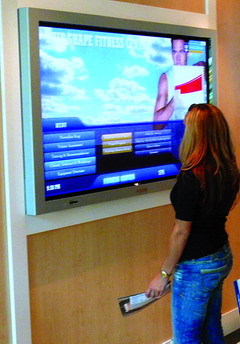

 Photo Gallery3 days ago
Photo Gallery3 days ago
 Headlines2 weeks ago
Headlines2 weeks ago
 Sector Spotlight2 weeks ago
Sector Spotlight2 weeks ago
 Headlines1 week ago
Headlines1 week ago
 Headlines5 days ago
Headlines5 days ago
 Headlines3 days ago
Headlines3 days ago
 Headlines2 weeks ago
Headlines2 weeks ago
 Designer Dozen1 week ago
Designer Dozen1 week ago
